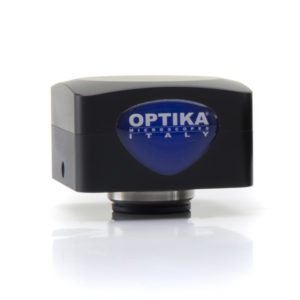High Level Microscope Cameras


High Sensitivity Fluorescence Cameras
In order to detect the often low levels of fluorescence emitted by specimess, cameras used in fluorescence microscopy must have particular features, including high sensitivity and low noise, in order to capture as many photons as possible.
These cameras are typically equipped with CCD sensor, although nowadays there is always a larger selection of scientific-grade CMOS.
Monochrome cameras are usually more suited to fluorescence imaging as they do not have a colour filter array, and enable more photons to reach the sensor, increasing their sensitivity very significantly compared to the color sensors.
The most indicated camera depends case by case, as it is of fundamental importance to consider the sample being imaged, the fluorochromes used, the required frame-rate, field of view, resolution and sensitivity.
All these elements drive to the selection of the right camera for a specific use.


CCD cameras are ideal for fluorescence imaging: they produce black and white images, although, red, green or blue coloured filters can be placed
on top of each pixel, allowing one primary colour to be read from each pixel. Limitations of CCD cameras include a higher read noise as well as
limited frame rates. Scientific-grade CMOS cameras ensure faster frame rate and a lower read noise compared to CCD cameras. They typically
provide a large field of view and high resolution, being preferred also for the high dynamic range and low noise. However, binning is less advantageous
with sCMOS sensors than with CCD sensors.
Monochrome cameras provide a much higher sensitivity than to the one equipped with color sensors; therefore, unless
multiple wavelengths are being imaged at the same time, monochrome cameras are best to use for fluorescence imaging.
Monochrome cameras ensures color reproduction via software on captured images, whilst color cameras are preferred when colors need to be
observed also during the live view.
Global shutter cameras are designed when particularly high-motion captures are needed, being perfect
for enabling ‘freeze frame’ of fast changing events, exposing each and every pixel simultaneously on PC/Laptop.
Superb with moving specimens thanks to the generous dynamic range which gives a great response to light and dark at the same time.
Resolution is particularly important in morphological imaging, patch clamping and network studies. It is the minimum point to point distance of the sample that can be distinguished as separate points on the image.
A larger number of smaller pixels gives a higher resolution. Do not forget that the resolution is also affected by the numerical aperture (NA) of
the objective.
Frame rate is the number of frames, or images, that are captured by the camera per second, extremely important in case of fast events. Each camera has a maximum number of frames that it can image when using the whole camera chip.
CMOS cameras usually have a higher frame rate than CCD cameras. Frame rate can be improved by binning, decreasing exposure time, reducing the region of interest being viewed and changing the PC connection.
Sensitivity is particularly important in low-light fluorescence, and if small changes in fluorescence need to be detected. The sensitivity of a camera determines how clear the image produced is: a camera with high sensitivity has a high signal-to-noise ratio, as it has a high capacity to capture signal from the surrounding noise. A longer exposure time can also improve the signal-to-noise ratio. Dark noise laso affects sensitivity and therefore image clarity.
Cooling systems affect the dark noise, which then affects sensitivity and therefore image clarity. Dark noise is defined as the noise caused by the liberation of electrons in the chip by environmental heat. Dark noise can be dramatically reduced by cooling the camera, but this is often expensive…



